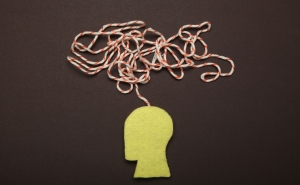Going Deep Into the Why of Suicide
Digital records on health care, schools, social services, and other agency data, along with information from family interviews, may help identify drivers of suicide—as well as opportunities to intervene.

When someone takes their own life, they also take with them the answers to so many questions.
Maryland’s new Suicide Fatality Review Committee aims to go beyond the medical examiners’ findings of where, when, and how to delve into the why behind suicides. Those answers could potentially prevent others from following the same path.
“We’re going to be putting together information like a puzzle to try to elucidate what the full picture of an individual’s life was like, based on the data that we can gather,” says Mental Health Professor Holly Wilcox, PhD ’03, who sits on the Committee. “With that information in hand, we will be able, I believe, to make great strides in thinking about how to fill gaps and coordinate services.”
Established in October 2022 by the Maryland General Assembly, the Committee is the culmination of three years of work that involved state lawmakers, advocates, suicide loss survivors, and experts, including Wilcox, who testified in support of creating the Committee, as well as other School faculty members.
The panel will rely heavily on databases from a range of state agencies that are typically confidential—digital records on health care, schools, social services, juvenile justice, disability services, insurance coverage, employers—to identify systems that the person interacted with to build detailed narratives of lives cut short.
“Suicide … hasn’t been investigated in this type of way, and we’re one of the first states to pass legislation to be able to do this and create a process to look at suicides in depth,” says Janel Cubbage, MPH, MS, Strategic Partnerships and Equity Program manager with the Center for Gun Violence Solutions.
“This can provide data to really pinpoint where we need to focus our efforts and help us to tailor our prevention strategies instead of trying to throw different evidence-based interventions at the wall and see what works,” says Cubbage, previous chair of Maryland’s Suicide Prevention Commission and director of Suicide Prevention for Maryland’s Department of Health.
Especially important for the Committee is shedding light on vulnerable groups who have not been well-represented in suicide research.
A notable exception is a December 2020 study by Hopkins researchers that found suicides of Black Marylanders nearly doubled during the first wave of the pandemic compared with the means from 2017 to 2019, while suicide mortality almost halved among whites, for whom suicide is more common generally. Study co-authors include Cubbage and psychiatrist Paul Nestadt, MD, associate professor in Psychiatry and Behavioral Science at the School of Medicine with a joint appointment in Mental Health, who sits on the Committee and testified before the Maryland legislature to support its establishment.
Researchers hypothesized that economics and health care disparities were at play, but a deeper investigation might have yielded more detailed information.
“Did they submit an unemployment claim? Were they able to access unemployment, or is this someone that still had to report for work as a frontline essential worker?” asks Cubbage. “We are really just left with our educated guesses and not any concrete data or information on what happened or how we could respond better in the future.”
Key goals of the Committee are to identify service gaps and trends and commonalities among suicides, information that could lead to actionable steps and inform prevention opportunities such as policies, education, and interventions.
If, in its work, for example, the panel identifies a trend of suicides among transgender students, a first step might be putting in place more support to students through outreach to Gay Straight Alliance groups, implementing programs that aim to improve school climate, and providing information about The Trevor Project 24/7 services. The Committee might learn that adolescents in a specific district are struggling and proactively recommend school-based mental health trainings for students in affected schools.
Beyond school-focused efforts, the group may find that a number of suicides occurred among individuals after dropping out of substance treatment programs and recommend that treatment providers establish peer-to-peer programs to help patients get support between health care appointments. The response could also involve connecting people with wraparound services like housing or food subsidies.
In addition to analyzing data from agencies, the Committee will also employ “psychological autopsies” in which a trained clinician interviews the family of someone who dies by suicide to obtain an individual-centered portrait in addition to the systems-focused, data-driven perspective. This work will be headed up by Nestadt, who is also conducting his own research on psychological autopsies.
The idea is that by talking with people who had recent interactions with someone who takes their own life—over days, weeks, or months—it might be possible to create a more nuanced portrait of the individual than records alone can and to identify common themes among suicide cases.
In Oregon, for example, psychological autopsies found several cases where people gave their pets away before dying by suicide, sometimes taking them to SPCA shelters. “So a suggestion was to put up suicide hotline numbers in shelters,” said Nestadt. “It’s a missed point of contact that never would have occurred to me.”
In Nestadt’s psychological autopsy work on firearm suicides among youth, three of the first 10 investigations revealed that the young people were playing violent online video games and choosing to have their in-game character die by suicide.
“I’m not saying every time someone dies in a video game, call the police, but maybe when it’s part of a larger constellation of things happening, like they’re dying in a video game, they’re also drinking more or their grades are dropping we can build on that to develop a targeted intervention,” says Nestadt.
The Committee is set to begin its work at a time when the CDC, according to data released April 13, reports that the U.S. suicide rate rose in 2021 after two years of decline, making suicide the second top cause of death in people ages 10–14 and 20–29. The 4% jump to 14 deaths per 100,000 represents the largest annual increase in the suicide rate in two decades.
“I believe there’s so much we’re going to learn from this Committee,” says Wilcox. “I feel it’s going to provide a model for other states and, in this process, how we can use data and coordination and collaboration to reduce suicide.”
Jackie Powder is the assistant editor of Hopkins Bloomberg Public Health magazine.




